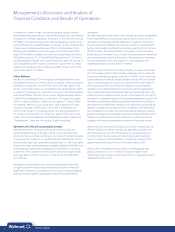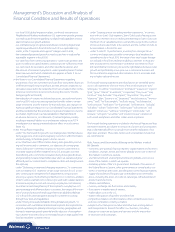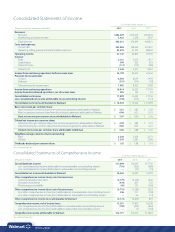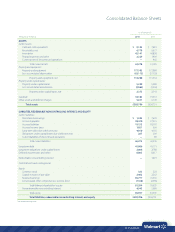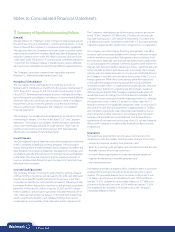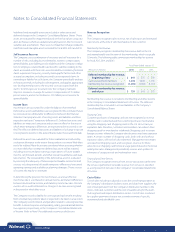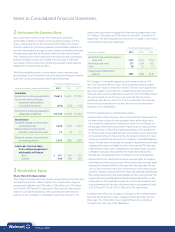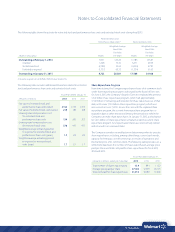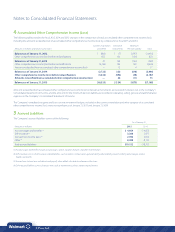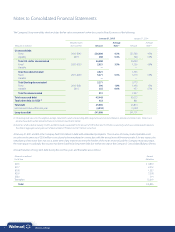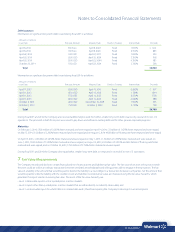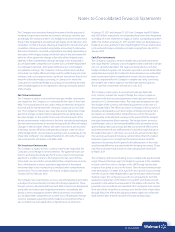Walmart 2015 Annual Report Download - page 44
Download and view the complete annual report
Please find page 44 of the 2015 Walmart annual report below. You can navigate through the pages in the report by either clicking on the pages listed below, or by using the keyword search tool below to find specific information within the annual report.
42 2015 Annual Report
Indefinite-lived intangible assets are included in other assets and
deferred charges in the Company’s Consolidated Balance Sheets. These
assets are evaluated for impairment based on their fair values using valu-
ation techniques which are updated annually based on the most recent
variables and assumptions. There were no impairment charges related to
indefinite-lived intangible assets recorded for fiscal 2015, 2014 and 2013.
Self Insurance Reserves
The Company uses a combination of insurance and self insurance for a
number of risks, including, but not limited to, workers’ compensation,
general liability, auto liability, product liability and the Company’s obliga-
tion for employee-related health care benefits. Liabilities relating to the
claims associated with these risks are estimated by considering historical
claims experience, frequency, severity, demographic factors and other
actuarial assumptions, including incurred but not reported claims. In
estimating its liability for such claims, the Company periodically analyzes
its historical trends, including loss development, and applies appropriate
loss development factors to the incurred costs associated with the
claims. To limit exposure to certain risks, the Company maintains
stop-loss insurance coverage for workers’ compensation of $5 million
per occurrence, and in most instances, $15 million per occurrence for
general liability.
Income Taxes
Income taxes are accounted for under the balance sheet method.
Deferred tax assets and liabilities are recognized for the estimated future
tax consequences attributable to differences between the financial
statement carrying amounts of existing assets and liabilities and their
respective tax bases (“temporary differences”). Deferred tax assets and
liabilities are measured using enacted tax rates in effect for the year in
which those temporary differences are expected to be recovered or set-
tled. The effect on deferred tax assets and liabilities of a change in tax rate
is recognized in income in the period that includes the enactment date.
Deferred tax assets are evaluated for future realization and reduced by
a valuation allowance to the extent that a portion is not more likely than
not to be realized. Many factors are considered when assessing whether
it is more likely than not that the deferred tax assets will be realized,
including recent cumulative earnings, expectations of future taxable
income, carryforward periods, and other relevant quantitative and quali-
tative factors. The recoverability of the deferred tax assets is evaluated
by assessing the adequacy of future expected taxable income from all
sources, including reversal of taxable temporary differences, forecasted
operating earnings and available tax planning strategies. These sources
of income rely heavily on estimates.
In determining the provision for income taxes, an annual effective
income tax rate is used based on annual income, permanent differences
between book and tax income, and statutory income tax rates. Discrete
events such as audit settlements or changes in tax laws are recognized
in the period in which they occur.
The Company records a liability for unrecognized tax benefits resulting
from uncertain tax positions taken or expected to be taken in a tax return.
The Company records interest and penalties related to unrecognized tax
benefits in interest expense and operating, selling, general and administra-
tive expenses, respectively, in the Company’s Consolidated Statements
of Income. Refer to Note 9 for additional income tax disclosures.
Revenue Recognition
Sales
The Company recognizes sales revenue, net of sales taxes and estimated
sales returns, at the time it sells merchandise to the customer.
Membership Fee Revenue
The Company recognizes membership fee revenue both in the U.S.
and internationally over the term of the membership, which is typically
12 months. The following table summarizes membership fee activity
for fiscal 2015, 2014 and 2013:
Fiscal Years Ended January 31,
(Amounts in millions) 2015 2014 2013
Deferred membership fee revenue,
beginning of year $ 641 $ 575 $ 559
Cash received from members 1,410 1,249 1,133
Membership fee revenue recognized (1,292) (1,183) (1,117)
Deferred membership fee revenue,
end of year $ 759 $ 641 $ 575
Membership fee revenue is included in membership and other income
in the Company’s Consolidated Statements of Income. The deferred
membership fee is included in accrued liabilities in the Company’s
Consolidated Balance Sheets.
Shopping Cards
Customer purchases of shopping cards are not recognized as revenue
until the card is redeemed and the customer purchases merchandise
using the shopping card. Shopping cards in the U.S. do not carry an
expiration date; therefore, customers and members can redeem their
shopping cards for merchandise indefinitely. Shopping cards in certain
foreign countries where the Company does business may have expiration
dates. A certain number of shopping cards, both with and without
expiration dates, will not be fully redeemed. Management estimates
unredeemed shopping cards and recognizes revenue for these
amounts over shopping card historical usage periods based on historical
redemption rates. Management periodically reviews and updates its
estimates of usage periods and redemption rates.
Financial and Other Services
The Company recognizes revenue from service transactions at the time
the service is performed. Generally, revenue from services is classified
as a component of net sales in the Company’s Consolidated Statements
of Income.
Cost of Sales
Cost of sales includes actual product cost, the cost of transportation to
the Company’s distribution facilities, stores and clubs from suppliers, the
cost of transportation from the Company’s distribution facilities to the
stores, clubs and customers and the cost of warehousing for the Sam’s
Club segment and import distribution centers. Cost of sales is reduced
by supplier payments that are not a reimbursement of specific,
incremental and identifiable costs.
Notes to Consolidated Financial Statements


